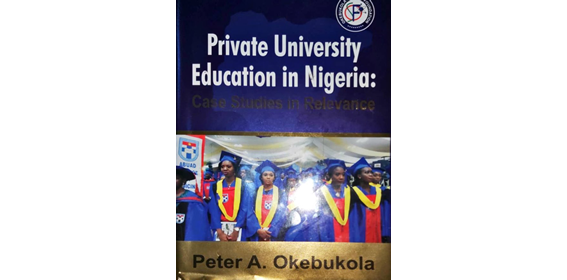Private University Education in Nigeria: Case Studies in Relevance.
Peter A. Okebukola (2017). Lagos/Slough: Okebukola Science
Foundation/Sterling Publishers. 161 pages
ISBN: 978-978-947-660.
Reviewed by Chido B. Nwakanma, School of Media and
Communication, Pan Atlantic University

Private universities are the future of higher education in Nigeria. Twenty
years after the first three private universities took off, universities in the
private sector model now number more than those of the federal or state
governments. Their number will grow even more.
At the time of writing in October 2017, this book documents 59 private
universities in Nigeria. The federal government accounted for 40, while
state governments had 44 universities. These are the assertions of the
author of this book, an expert on the subject.
Why are universities run by private sector players doing well? What do
they contribute and what justifies their existence and continued growth?
How can society assist such a positive development?
Private University Education in Nigeria: Case Studies in Relevance is an
advocacy book that justifies the presence and growth of private
universities in Nigeria and the need to extend to them the financial
assistance of the Education Trust Fund that public universities alone
currently enjoy. The lead advocate has solid credentials for the case.
As a former Executive Secretary of the National Universities
Commission, Prof Peter Okebukola brings to bear in-depth knowledge
and experience of the Nigerian university system. As a regulator of the
system, he understands both the requirements and the challenges. He
has also served on the Council or Boards of no fewer than four private
universities. He thus makes an informed case.
Private University Education in Nigeria proclaims that those institutions
provide access to candidates who would have been shut out,
reintroduced quality in higher education and offer efficient student-
focused service delivery. They also infused healthy competition into the
system and are focused on delivering quality research outputs. Private
universities, he adds, operate a delivery system wrapped around small
class sizes and well-resourced classrooms that stimulate the production
of good quality graduates and run a predictable academic calendar.
It lists seven positive attributes. They are contributors to high-level
human resource development, train persons with better values and
represent a model of university governance in observance of due
process, accountability and discipline. They also mostly have a Board of
Trustees as an additional layer for accountability. The institutions model
financial autonomy as they sink or swim from the income from ventures
and other sources that supplement tuition. Discipline is the language in
private universities for both staff and students while they are
adventurous in exploring new courses that go beyond the NUC’s
Benchmark Minimum Academic Standards (BMAS).
Nigeria had an initial false start with private universities when promoters
established 24 private institutions between 1980 and 1983. Criteria were
unclear. The Federal Government cancelled the process in 1984. The
nation then commenced a new operation with Decree 9 of 1993 that
allowed individuals, organisations, corporate bodies and local
governments to establish and run private universities once they meet the
guidelines. The book outlines the 14-step process that the National
Universities Commission applies for the licensing of private universities.
The first set of universities licensed and opened in 1999 are Igbinedion
University, Okada, Babcock University, Ilishan-Remo and Madonna
University, Okija.
Despite their positives, subscription of candidates to private universities
has been very low, the book discloses. Babcock University in 2017
UTME received 2645 applications, Covenant University 2633 and Afe
Babalola University 1240. All others had less than 1000 applications
each.
This book covers its subject matter in eight chapters, a dedication,
foreword, preface and a list of the 16 vice-chancellors who responded
for their institutions.
The relevance of private universities is the central thesis of Private
University Education in Nigeria. The book explores this relevance in
nine areas. These are national and global economy, agriculture and food
security, education, and manufacturing. Others are power, youth
employment, peacebuilding, religious harmony and conflict resolution as
well as research, innovation and development of new products.
Sixteen universities reported on their contributions as the basis for the
case studies. A revised edition of the book should have actual case
studies and not the brief notes that some of the institutions passed on.
When you hear case studies, you expect diligent reporting “involving an
up-close, in-depth, and detailed examination of a subject of study, as
well as its related contextual conditions”. This section requires the
application of rigour.
Private University Education in Nigeria offers perspective with a look at
the trajectory of private universities in the USA, Britain and Europe. It
features Harvard University, MIT, Stanford and Yale. There is the
University of Buckingham, Ukrainian Free University, and the Catholic
University of Sacred Heart, Milan. It reports that Japan has 597 private
universities that constitute 78% of its universities. Indonesia has 1200 or
60% while the number for China has exploded from 20 in 1997 to 630 in
- Before 1995, only Ghana, Zimbabwe and Kenya had privately-
owned universities in Anglophone Africa.
The book could do with better editing and attention to detail in this area.
This extract on Stanford University, for instance, states, “It has evolved
from making global impact to devising a mutually beneficial means that
ensured that by 2015 78% of its undergraduate (s) graduated debt-free,
that is a rare feat in the nation’s tertiary education system” (p78). Which
nation? There is no attribution either.
The case for TETFUND support is persuasive. Okebukola argues that
since the private sector is the goose that lays the golden egg of
TETFUND, private universities should also benefit from the Tertiary
Education Trust Fund. The pillars of the case are history, the relevance
of the institutions and the need for equity.
The author then suggests modalities for the inclusion of the private
sector. These include deploying the same formula as used for the public
institutions, basing it on defined performance criteria, or differentiated
funding that gives a higher percentage to public schools. Others are
finance based on survivors of a stress test or providing low-interest
loans to the institutions.
Private University Education in Nigeria: Case Studies in Relevance
delivers on its assigned task of making a case for the existence and
contributions of higher institutions promoted by the private sector. The
reader would find abundant material in the history of higher education in
Nigeria, the growth of private funding and the projection that private
universities would eventually dominate.

